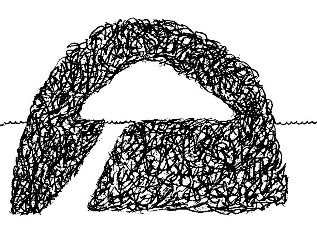
Habitat and Geography:
Home Sweet Home
Muskrats can be found in a variety
of habitats ranging from marshes, river, streams, lakes,
ponds,
and most other wetland habitats. Muskrats are very widely
dispersed, and inhabit wetlands throughout Eastern United States
and Canada. They can also be found now in parts of Europe and
Asia since being brought over around the beginning of the
twentieth century. Muskrats living in aquatic environments such
as a marsh can be found near the shallow parts of the body of
water living in constructed lodges and will almost always be in
the water. They will only venture out of the water if it is
necessary, such as moving to a new location for more food
sources and room to reproduce.
Suitable habitats for muskrats must contain slow moving
water, aquatic and submergent vegetation for eating and building
lodges, and a water depth of about two to four feet. The
muskrats prefer slow moving water over fast moving water to
build their lodges in and be able to swim around easily since
they are primarily aquatic mammals. Submergent and aquatic
vegetation is a necessary part of their habitat for muskrats to
prosper because they serve as their primary source of food and
materials for lodge building. These plants include: marsh
bulrush, common cattail, common duckweed, pond lilies, and many
other vegetation that can be found in their habitat. The depth
of water is very important relative to the success of a
population of muskrats. This is because if the water depth is
too low (less than ~two feet) there will not be enough water to
swim in to forage when the ice is frozen during winter and the
beginning of spring. Also if the water levels are too high (more
than ~five feet) such as during a flood, the submergent and
aquatic vegetation that the muskrats are dependent on could
possibly be replaced with a different plant species that would
be able to live well in the deeper water.
Muskrats build their own homes called lodges that look similar
to beaver lodges. They are made
out of mostly emergent
vegetation and are usually rebuilt each year between August and
October. These lodges can be about three to four feet high and
about six to eight feet wide. Muskrats will sometimes start
building them on top of old deteriorated lodges or will find a
new spot to start the construction. Typically muskrats build two
types of lodges; the most important one is the lodge where they
will reside in during the winter months, and the second one is a
feeding platform that can be utilized throughout the whole year.
The feeding platform, however, is much smaller than the lodges
that the muskrats live in.

Usually two or muskrats will aid in building the lodge,
such as a mating male and female, and they will start by finding
a sturdy area to build on. This could be an old lodge or feeding
platform, and it will serve as the base of their lodge. Once
this base has been found, the muskrats will start to pile
emergent plants that they can find and harvest near where they
are building their lodge. They will do this until it is the size
that they want. They then carve out a plunge hole which is used
to enter and exit the lodge from underwater. Once that is
finished, they build tunnels that can be used for several
purposes. Some of these purposes i nclude
space for breeding, winter burrows which is a small tunnel with
a chamber attached to it, and burrows used for feeding. Finally,
the muskrats carve out a hollow space in the middle of the domed
part of the lodge which will serve as the nest chamber where
they will be living all winter. The lodges they build for the
winter have very thick walls to keep heat in while the
temperatures are below freezing. Muskrats will also dig tunnels
and chambers into the embankment of the body of water that they
inhabit. During the winter muskrats will also make structures
called push-ups. These are basically platforms that sit on top
of the ice and are used to rest on and eat on during the winter.
They are made by gnawing a hole through the ice and pushing
vegetation out of the hole until it is about two feet in height
and a desirable size for the muskrat that is building it.
nclude
space for breeding, winter burrows which is a small tunnel with
a chamber attached to it, and burrows used for feeding. Finally,
the muskrats carve out a hollow space in the middle of the domed
part of the lodge which will serve as the nest chamber where
they will be living all winter. The lodges they build for the
winter have very thick walls to keep heat in while the
temperatures are below freezing. Muskrats will also dig tunnels
and chambers into the embankment of the body of water that they
inhabit. During the winter muskrats will also make structures
called push-ups. These are basically platforms that sit on top
of the ice and are used to rest on and eat on during the winter.
They are made by gnawing a hole through the ice and pushing
vegetation out of the hole until it is about two feet in height
and a desirable size for the muskrat that is building it.
Muskrats share their habitats with many other
organisms. These organisms include food sources, predators, and
other organisms that don’t affect how muskrats live their daily
lives. To see what types of food sources muskrats need to
survive, click here.
To see how muskrats have adapted to their
environment click here.
To go home click here.